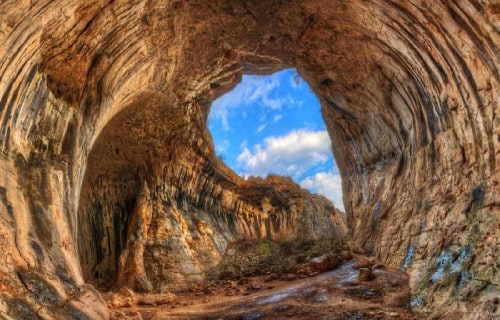
8 Swoon-Worthy Caves
The breathtaking beauty of our world includes more than just what greets the eye on the surface or beneath the waves, but also extends beneath the surface. It takes in the many caves and tunnels found throughout the world, in nearly all regions. Here, in this world beneath the surface of the earth, we can find otherworldly shapes and formations of startling beauty and grandeur. Here we list for you our choice for 8 Swoon-Worthy Caves. We hope you enjoy them as much as we do.
- Reed Flute Cave
- Cango Caves
- Er Wang Dong
- Prohodna Cave
- Blue Grotto
- Fingal’s Cave
- Lechuguilla Cave
- Devetashka Cave
Reed Flute Cave
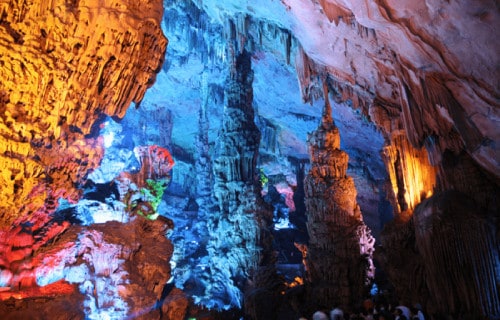
CL: https://bit.ly/1ryPA8o
Reed Flute Cave Facts
- The Reed Flute Cave represents a natural limestone cave in Guilin, Guangxi, China, in Asia. It draws its name from the presence of a species of reed growing outside the cave.
- This reed also remains rather common in the making of flutes, even today.
- The interior of this geological masterpiece sits full of a wide variety of stone pillars, stalactites, and rock formations which were created by carbonate deposition over millions of years.
- Also, among the many remarkable formations found within the cave, one even bears a strong resemblance to the Statue of Liberty, in the United States.
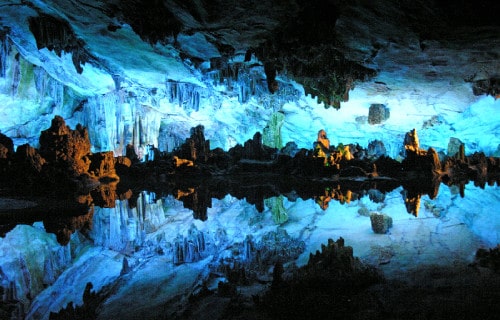
CCL: https://bit.ly/1jxQJMa
Reed Flute Cave Physical Description
The incredible Reed Flute Cave measures roughly 790 ft (240 m) in length. Heights of the roof also vary greatly from location to location over its length.
This walls of this rather astonishing natural beauty consist principally of limestone, which has been extensively eroded by water.
The cave also serves as home to numerous collections of impressive stalagmites and stalactites. These formed over thousands of years via the action of carbonate deposition.
Further, it also contains several large bodies of water.
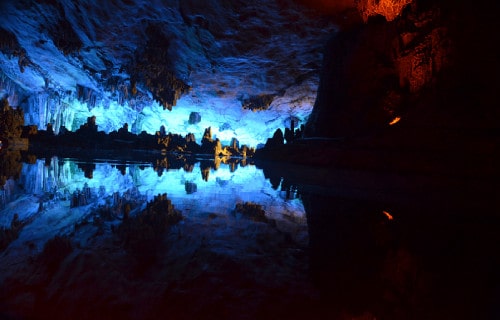
CCL: https://bit.ly/1p2b8Ke
Reed Flute Cave Human History
The Reed Flute Cave was popular to local inhabitants in ancient times. Mysteriously, people forgot about the cave for nearly 1,200 years or until the mid 20th century.
Refugees fleeing from Japanese troops in the 1940s accidentally rediscovered the cave and made it popular once again.
The cave also hides more than 70 inscriptions written in ink and dating to as early as 792 AD, in the time of the Tang Dynasty.
The inscriptions indicate that the rather long cave was a popular tourist location even then.
Cango Caves
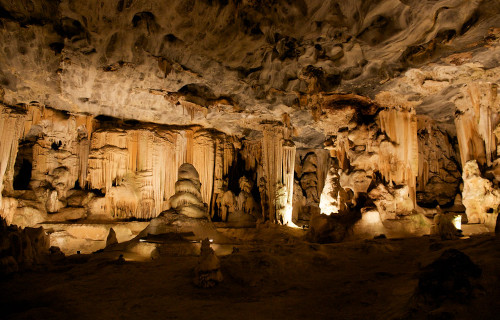
CCL: https://bit.ly/2UI96aD
Cango Caves Facts
- Many people consider the most noteworthy fact about the Cango Caves to be their status as the most extensive and best known geological marvel of its kind found anywhere in the region.
- This complex of caves and tunnels also happens to be extremely old. The limestone in which they appear formed during the Precambrian Period, and the caves and tunnels formed approximately 20 million years ago.
- The site remains one of the most popular tourist sites in the region, yet tourists can only access approximately one-fourth of their extent. In addition, tourists can only enter the complex as part of a supervised group.
- The utilization of the Cango Caves began long ago. Stone artifacts found within the caves indicate that primitive man used them for shelter in both the Middle and Late Stone Age.
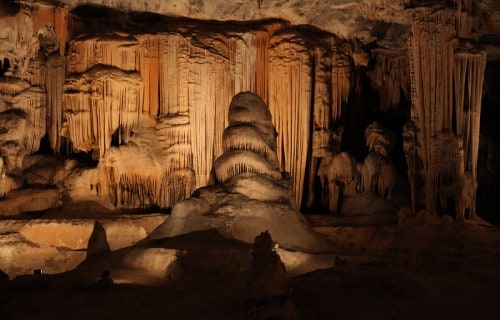
Cango Caves Physical Description
The remarkable Cango Caves consist of a series of an extensive series of hidden chambers and connecting tunnels. While only a portion remains accessible by the public, the entire system extends for approximately 2.5 mi (4 km).
Numerous large chambers connected by twisting tunnels contain marvelous sights and experiences. The chambers vary in size, yet the largest measures approximately 984 ft (300 m) in length.
The deepest section of the complex also lies an equal distance beneath the surface. In addition, thousands of stalagmites and stalactites fill the various chambers.
Also, the surrounding rock primarily consists of ancient limestone. A small underground river also flows through some of the chambers and tunnels.
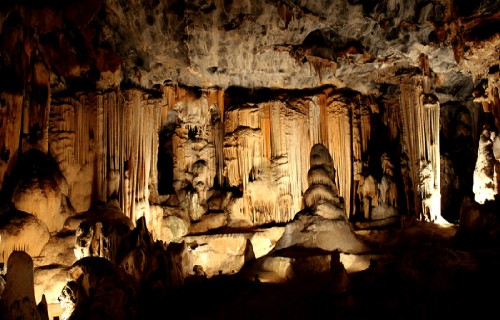
Cango Caves Location, Formation and Exploration
The magnificent Cango Caves formed in what now constitutes the country of South Africa, in Africa. The nearest town sits approximately 10 mi (16 km) away.
This complex originally formed as a series of dripstone caverns and lies in a limestone ridge running parallel to the Swartberg Mountains. The first recorded discovery of the complex in modern times occurred in 1780, yet archaeological evidence places human usage of the site as far back as nearly 300,000 years ago.
The first known attempt to map the system occurred in 1897. In addition, the first scientific mapping of the complex was carried out by the South African Speleological Association, in 1956. It also remains important to note that there may be more to the complex than we currently know, as portions of it still lie under water.
It also remains important to note that there may be more to the complex than we currently know, as portions of it still lie under water.
Er Wang Dong
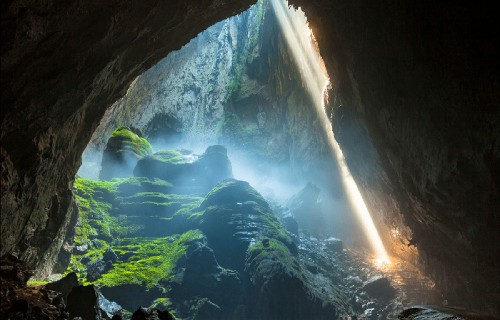
Er Wang Dong Facts
- The breathtaking Er Wang Dong represents an incredible marvel of geology only recently discovered. Prior to 2012, its true extent was unknown.
- This natural marvel developed into an enormous cave system. Although nitrate miners have long used a few of the smaller surface caves, no one realized the marvels that lay further down.
- A team of intrepid explorers finally investigated the gargantuan system in 2012. In fact, they spent more than a month doing so.
- Many tunnels still remain a mystery. So far, the total explored tunnel length has reached 138,251 ft (42,139 m). There is even a cavern so huge that it actually contains its own weather system.
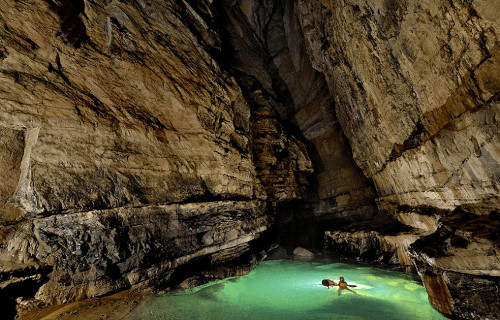
Er Wang Dong Formation and Geology
The truly magnificent Er Wang Dong formed in what scientists call the Ordovician Period. This period lasted a total of nearly 45 million years, beginning roughly 488 million years ago.
The majority of the walls, floors, and formations formed from native limestone. Long-term erosion by flowing water has further carved out the incredible caves and tunnels.
Later deposits of sandstone atop the limestone subsequently aided in preserving much of the incredible system as we see it today.
Countless stalagmites and stalactites, some of them rather huge, appear throughout the vast stretch of the entire system.

Er Wang Dong Distinctiveness and Meteorology
The absolutely mind-blowing marvel that locals named Er WAng Dong formed in what now constitutes the Chongquing province of China, in Asia.
Perhaps the most astonishing feature of Er Wang Dong remains the Cloud Ladder Hall. This is an enormous chamber with a total volume of roughly 549,000 sq ft (51,000 sq m).
Put in perspective, this is bigger than the area of St. Peters Basilica (both interior and exterior) in the Vatican City.
The roof of this cavern is roughly 820 ft (245 m) high. The height of the cavern and the amount of moisture inside actually allows clouds to form near the ceiling. Just take a moment to imagine that.
The floor of the cavern remains covered with lush vegetation. Er Wang Dong also contains a modest-sized underground river, as well as a large sinkhole. Further explorations are in planning.
Prohodna Cave

Prohodna Cave Facts
- The visually stunning and rather unique Prohodna Cave truly represents a most unusual example of a highly specific type of cave located in Europe.
- Its most easily recognizable feature remains the two distinctly eye-shaped openings in the ceiling. Rather surprisingly, these have roughly the same size and shape.
- This rare and rather fascinating double formation, known as Okanata, which means windows, was featured prominently in a locally produced film entitled Time of Violence.
- Given its astounding beauty and distinctiveness, this site easily ranks as one of the most popular tourist sites in the region, as remains famous throughout the world.
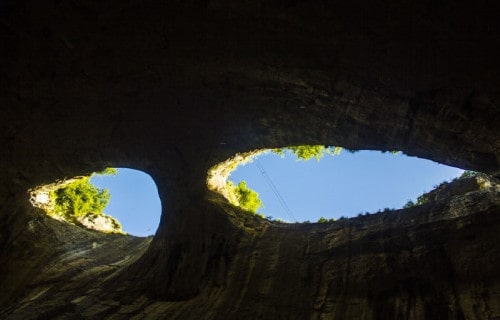
Prohodna Cave Physical Description
The truly impressive Prohodna Cave itself ranks as a moderately large cave. It measures roughly 860 ft (262 m) in length. This also makes it the longest cave passage in the country it formed in.
This magnificent wonder of geology also has two entrances. Fascinatingly, these lay directly opposite each other. For obvious reasons, they bear the names of the Big Entrance and the Small Entrance.
The Big Entrance also measures 148 ft (45 m) in height, while the Small Entrance measures only 115 ft (35 m) high.
To further amaze us, Nature allowed for the two openings to form in roughly the center of the ceiling of the large chamber.
Together, the two entrances allow great amounts of sunlight to enter the cave. As a result, vegetation can be found growing in places throughout its length.

Prohodna Cave Location, Formation, and History
The gorgeous Prohodna Cave also formed in what now represents the country of Bulgaria, in Europe. It sits roughly 1.2 mi (2 km) from the village of Karlukovo.
This cave sits in the Karlukovo Gorge, which itself forms part of the Geological Park Iskar-Panega. This constitutes one of the largest karst regions in the country.
This stunning site also represents what experts call a karst cave. The walls and ceiling primarily contain limestone, which gradually eroded due to the action of flowing water.
Evidence found in various locations in the cave also indicates that humans have been aware of and made use of the cave for nearly 12,000 years.
A national movement in 1966 quite understandably named this rather breathtaking location as one of the 100 Tourist Sites of Bulgaria.
Blue Grotto
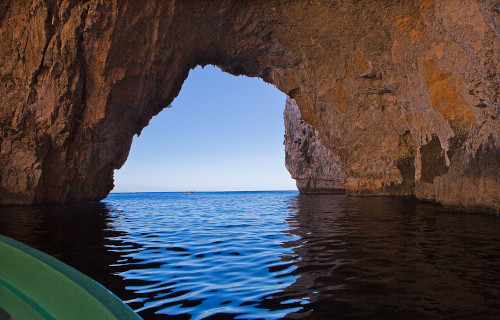
CCL: https://bit.ly/2SJlUwS
Blue Grotto Facts
- The Blue Grotto constitutes an incredibly picturesque naturally occurring sea cave. The cave formed on the island of Capri, in southern Italy, in Europe.
- It remains famous for the unique, naturally occurring blue lighting within the cave. The grotto stays lit by a unique combination of lighting from two separate sources.
- The Blue Grotto also extends a distance of roughly 177 ft (54 m) into the cliff. The depth of the cavern measures about 492 ft (150 m).
- The gorgeous cavern has a small entrance, measuring around 5 ft (1.5 m) in width, at the waterline. Yet despite this, the Blue Grotto forms one of the leading tourist attractions on the island.
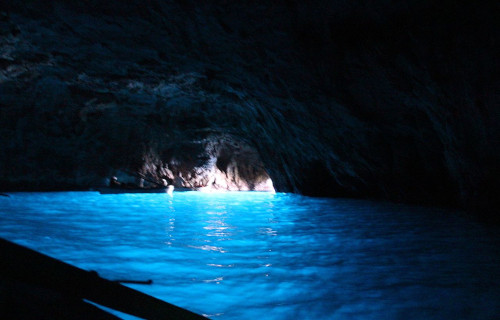
CCL: https://bit.ly/3dEHnyt
Blue Grotto Lighting Effects
The Blue Grotto has an illumination consisting of an ethereal brilliant blue lighting. This startling effect occurs due to dual sources. The first comes from the small entrance at the waterline, yet the primary source of lighting actually consists of the second source.
This is the second hole, directly below the first, and the two remain separated by a bar of rock, around 6 ft (2 m) thick. The second hole also measures nearly 10 times the size of the upper entrance.
Thus the cave actually receives its primary lighting from below the waterline. Another quirk of geology also exists in the cavern involving the lighting effects.
It is impossible for a visitor to discern the shape of the underwater hole, the outline of the stone bar, or even the nature of the lighting source.

Blue Grotto Historical Relevance
The Blue Grotto became a popular tourist spot in modern times, especially since the 1830s. However, evidence indicates that men knew of it as far back as the Roman Age.
Before their removal, sculptures from the pantheon of Roman deities originally existed in the grotto. Experts also believe that more such statues remain at the bottom of the cave.
The Roman Emperor Tiberius also (according to legend) frequented the site after he retired to Capri. Research uncovered the remains of an ancient man-made landing from that era.
Local inhabitants knew of the grotto but largely avoided it after the end of the Roman Era. In ancient times, this was primarily due to the belief that the Blue Grotto was inhabited by witches and various supernatural creatures.
Fingal’s Cave
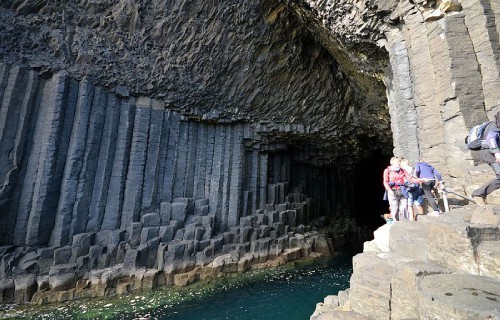
CCL: https://bit.ly/1SrbRBk
Fingal’s Cave Facts
- Fingal’s Cave represents a natural wonder that exemplifies the aura of mystery and magic often associated with Scotland and also remains a marvel of geology.
- It formed as a sea-cave found on the uninhabited island of Staffs (Staffordshire); part of the Inner Hebrides. Fingal’s Cave formed entirely from jointed hexagonal basalt columns and stays partially filled by the sea.
- The unique structure of the columns also formed as a result of cooling lava flows.
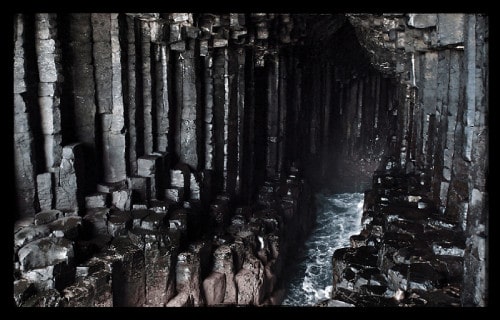
Fingal’s Cave Physical Characteristics
Fingal’s Cave possesses a rather large arched entrance, followed by a much narrower passage into the rest of the chamber. This large entrance measures nearly 66 ft ( 20 m) in height.
The cave itself has a width of about 40 ft (12 m). In addition, the floor of the cave remains covered in water to a depth of roughly 25 ft (7.6 m).
Due to its dimensions, the echoes produced by the waves create a cathedral effect that has been described as hauntingly beautiful.
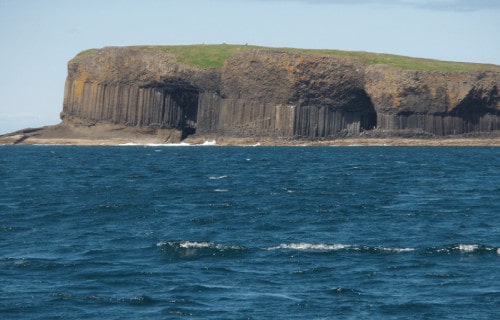
Fingal’s Cave Formation and History
The incredible Fingal’s Cave formed entirely from a lava flow during the Paleocene Era. Experts believe that the same flow that formed the remarkable hexagonal basalt columns here also formed the Giant’s Causeway.
Among the most memorable sights in Europe, the uniquely shaped columns formed as the result of cracks that occurred during the cooling process.
It remains unclear when local residents first discovered the beautiful cave. However, it first came to the attention of the English-speaking world after being seen by naturalist Sir Joseph Banks in 1772.
The cave also now forms part of a National Nature Reserve and locals named it after the hero of an 18th-century poem.
Borra Caves
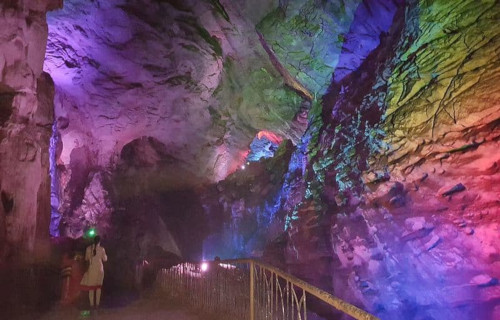
CCL: https://bit.ly/2XJI00e
Borra Caves Facts
- Next up among these choices for inclusionin this article about 8 Swoon-Worthy Caves comes the marvel of Nature known as Borra Caves.
- Most impressively, the incredible location known by the simple name ranks as one of the largest known caves in the country in which it formed. Its wonders don’t end there, however. The truly magnificent site also holds yet another impressive status.
- That’s because the fabulous site ranks as the deepest known cave in that same country. Quite surprisingly, this natural marvel of geology also sits at an usually high altitude. Though unknown, of course, such a combination nonetheless qualifies as unusual.
- The local indigenous population, furthermore, long knew of the presence of the natural marvel. In fact, they knew of its existence for countless centuries prior to its discovery by Europeans. Extensive archaeological evidence pointing to this fact exists.
- The caves first became known to outsiders, however, in 1807. This fortuitous discovery occurred as an accidental result of a geological survey of the country. William King George came across the site in the process of conducting that survey.
- Finally, this truly fabulous natural site also has yet one more reason to stand out. This one, though, comes in the form of a sociological importance. That’s because the Borra Caves also plays an important role in the religious beliefs of the local population.
- As part of these local beliefs, the native residents hold several legends revolving around the astounding caves. In fact, this even extends to the construction and maintenance of a small temple outside its opening, built at a currently undetermined date.
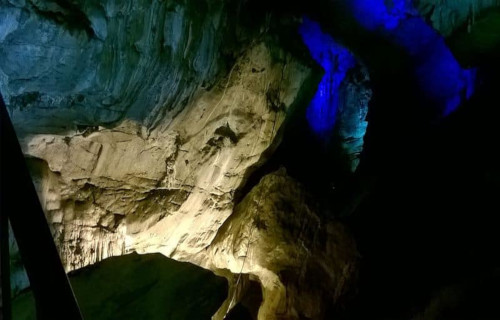
CCL: https://bit.ly/2qNNNps
Borra Caves Physical Description
Perhaps most notably of all, the endlessly amazing Borra Caves extend for a relatively great distance. That’s due to the fact that they have a total length measuring about 660 ft (200 m) in total. In fact, that’s an impressive measurement for a natural formation of this type.
The site also boasts a remarkably large opening. This measures roughly 330 ft (100 m) in width, and about 246 ft (75 m) in total height. Furthermore, this well known and always fascinating site also boasts numerous natural features, especially stalactites and stalagmites.
The wondrous stalactites range in length from 0.3 – 11.5 ft (0.1 – 3.5 m) in length. Meanwhile, the equally marvelous stalagmites have an average length of 3.9 ft (1.2 m). The stunning location also boasts even more magnificent features to dazzle the observer, though.
That’s because the awesome site also contains numerous fascinating limestone columns. These comparatively massive features average roughly 20 ft (6 m) in height and about 2.5 ft (0.75 m) in overall width. But the marvels of the Borra Caves do not simply stop there.
Nature, it seems, worked to create multiple wonders in this location. In point of fact, the surrounding area consists largely of impressive mica formations. Due to the unique nature of this site, numerous precious stones also appear within the mica, including rubies.
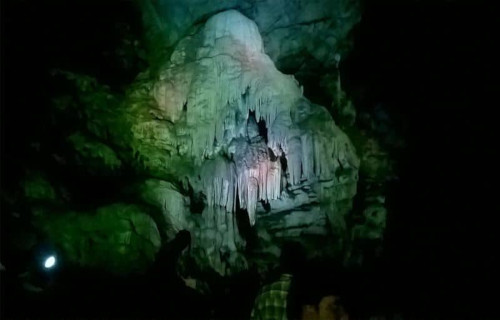
CCL: https://bit.ly/2pQ8WPz
Borra Caves Location, Formation, and Ecology
Remarkably, the magnificent Borra Caves formed in a part of the world that’s itself quite remarkable. This marvel of Nature formed on what now represents the East Coast of the country of India, in Asia. Herein, it blends in perfectly with many other natural wonders.
Rather more specifically, this geological wonder formed in what is now the Ananthagiri hills, in the district of Andhra Pradesh. The Gosthani River, more precisely, created the incredible site. That’s true because it actually originates within the caves, before flowing onward.
In fact, the flowing water, over countless thousands of years, carved the caves as they exit now. It did this through its inexorable actions against the relatively soft limestone of the region. That’s not an uncommon pattern of formation, but here it’s taken to another level.
While it may seem like an inhospitable location, a multitude of life actually teems within the boundaries of the Borra Caves. For one thing, several species of fauna inhabit the caves. These mainly, but not solely, include various types of bats, and the golden gecko.
But, this seemingly miraculous location also serves as home to several varieties of very tiny crustaceans, however. Very strong evidence further indicates that this fantastic site was known to ancient man, in the quite distant past, as well as modern humans.
This holds true due to the facts uncovered by numerous expeditions to the site. As a result of these, researchers discovered numerous archaeological artifacts within the confines of the caves. To their amazement, some of these date back roughly 50,000 years.
Devetashka Cave
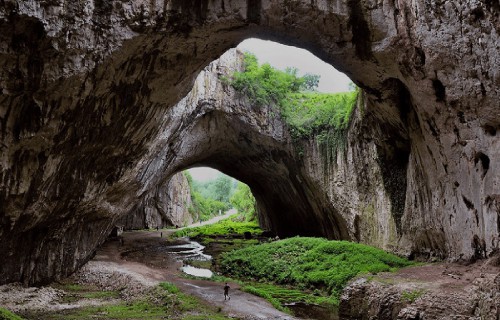
Devetashka Cave Facts
- Devetashka Cave serves as the name of a visually remarkable cave. Evidence also indicates that this incredible site has seen human habitation dating back tens of thousands of years.
- The cave remains famous for the seven differently sized holes which line its roof. These run along its length and allow sunlight to penetrate to the central hall, as well as to parts of its two separate fields.
- The rather large entrance to the cave measures about 115 ft (35 m) by 98 ft (30 m) in size.
- The unique and picturesque Devetashka Cave is now also a National Landmark as of June 1996.
- It has also served as the site of several films, due to its breathtaking and distinctive beauty.
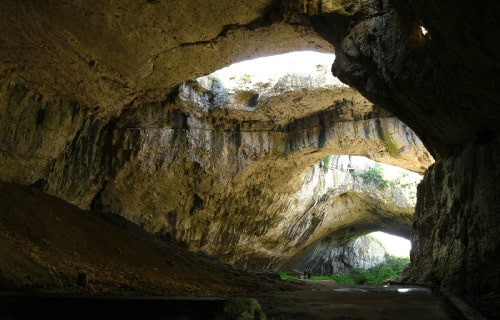
Devetashka Cave Twin Halls
Roughly 131 ft (40 m) into the incredible Devetashka Cave, it widens into an enormous hall. The magnificent ceiling of this hall reaches as much as 328 ft (100 m) high in places. In total, the entire hall has a total area of 25,833 sq ft (2,400 sq meters).
Roughly 650 ft (200 m) from the opening of the cave, it branches into two distinct fields. These two fields possess rather different features.
However, the wonders of this cave do not end with these incredible natural halls. There are other marvels of geology hiding within this site.
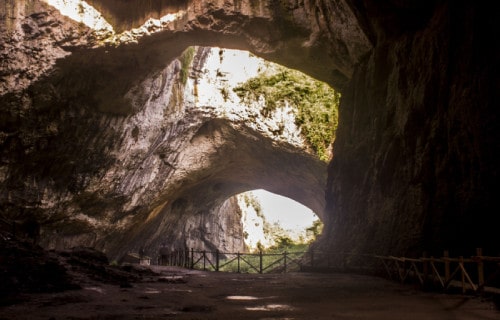
CCL: http://bit.ly/2zBWbKi
Devetashka Cave Location and Underground River
The stunning Devetashka Cave formed in the country of Bulgaria, in Europe. It is also situated very close to the village of Devetaki and forms one of the largest known caves in the country.
Within the cave, the left field is about 1.25 mi (2 km) in length. It also contains a small underground river flowing through it which empties into the Osam river.
The field to the right is dry and warm. After the entrance, the field widens into an almost perfectly rectangular hall. This hall is circa 49 feet (15 m) wide, and 164 feet (50 m) long.

CCL: https://bit.ly/2SJlUwS
8 Swoon-Worthy Caves
Of course, these 8 Swoon-Worthy Caves represent only the tiniest fraction of the known caves that dot the world. Furthermore, our selection is quite naturally a matter of perspective. Countless other magnificent caves cover the world, or at least, the land beneath the world. But it is up to us to preserve them for posterity. If you know of other caves or cave systems that you feel deserve a mention on lits such as this one, please let us know. We welcome hearing from you.
Check out our other articles on 6 Startling Evolutionary Adaptations, 7 Dazzling Desert Dwellers, 7 Stunning North American Lepidoptera









Leave a Reply